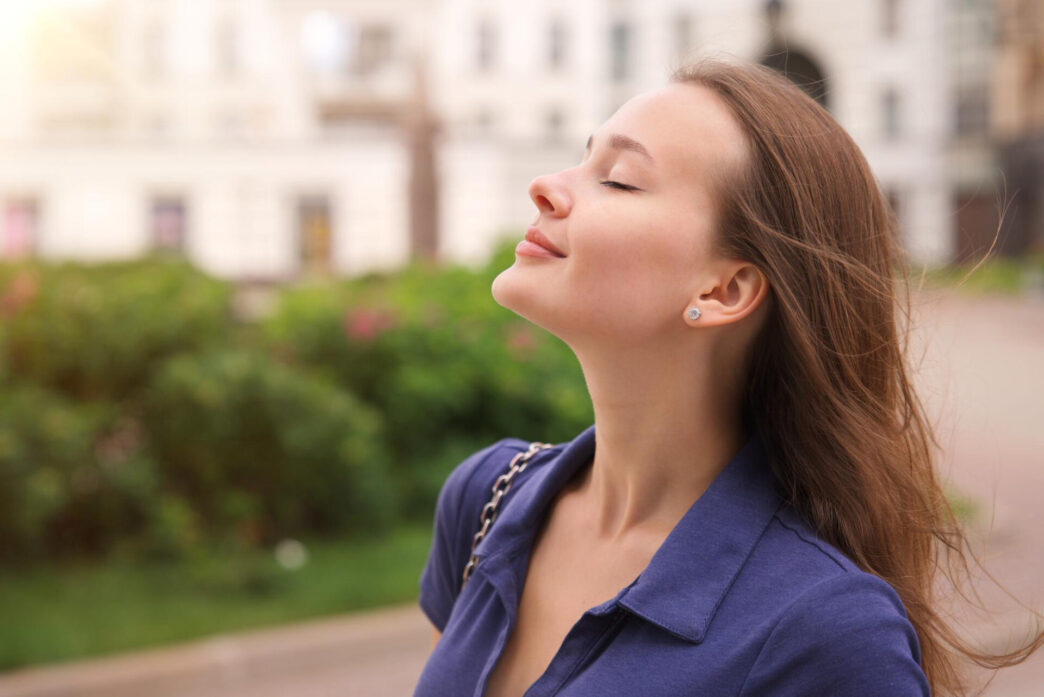Why Just Five Breaths Can Calm Anxiety Fast
In a world of constant pressure, quick relief from anxiety often feels out of reach. Medications take time, meditation requires practice, and distractions rarely offer more than temporary escape. But what if the solution was as close as your next breath?
The “Five Breaths to Calm Anxiety” method offers a science-backed, instantly accessible tool to deactivate stress and reset the nervous system in under 60 seconds—without apps, gear, or special training.
Not All Breaths Are Equal
Most people breathe from the chest in shallow, rapid bursts—especially when anxious. This type of breathing fuels panic and keeps the nervous system in high alert. In contrast, deep, slow, intentional breathing tells the brain: You are safe.
🧠 Breathing is the only automatic function you can control at will. By slowing the breath, you flip the body’s stress switch and return to calm.
“When you own your breath, nobody can steal your peace.”
What Makes These Five Breaths Different
The Five-Breath Method isn’t just about slowing down—it’s about strategically engaging the parasympathetic nervous system through specific inhale-exhale rhythms and short pauses.
This technique is rooted in four proven principles:
| Principle | Effect on Body and Mind |
|---|---|
| ✅ Deep inhale through the nose | Boosts oxygen, expands lung capacity |
| ✅ Slow exhale through the mouth | Lowers heart rate, reduces blood pressure |
| ✅ Brief pause after exhale | Stabilizes CO₂ and prevents hyperventilation |
| ✅ Final centering breath | Anchors awareness and resets emotional state |
Unlike long meditation sessions or complex pranayama techniques, this method works immediately, anywhere—at your desk, in traffic, before sleep, or during a panic spike.
Backed by Science, Built for Real Life
Researchers have confirmed that controlled breathing:
- Stimulates the vagus nerve, increasing heart rate variability
- Reduces cortisol levels and improves resilience to stress
- Improves focus, sleep, and emotional regulation
A growing number of studies suggest that deep breathing for anxiety outperforms many short-term interventions—especially when practiced regularly.
Whether you’re preparing for a presentation, calming racing thoughts, or just trying to stay grounded in chaos, five focused breaths can offer clarity and control in a moment of overwhelm.
What follows is a breakdown of each step of the method, along with the science behind why it works—so you can use it with confidence and calm, wherever life takes you.
The Five-Breath Method
Step 1: Ground Yourself
Before you begin, take a moment to shift your awareness to the present. Stress often pulls the mind in multiple directions, but grounding helps regain control.
✔️ Sit or stand with a straight spine—good posture allows for full lung expansion.
✔️ Place your feet flat on the floor—if sitting, ensure they are hip-width apart.
✔️ Relax your shoulders and jaw—release any built-up tension.
✔️ Close your eyes (if comfortable)—reducing visual input enhances focus.
Take one natural breath and observe how it feels. Don’t force anything—simply notice your breathing pattern before starting the technique.
Step 2: The Deep Inhale
✔️ Breathe in deeply through your nose for 4–5 seconds.
✔️ Let the air fill your lower lungs first, then expand your ribs, and finally lift your chest.
✔️ Keep the movement fluid—avoid unnecessary tension.
This type of diaphragmatic breathing maximizes oxygen intake, which is essential for relaxation. Research from Harvard Medical School shows that deep nasal breathing increases nitric oxide production, improving circulation and reducing stress responses.
Step 3: The Slow Exhale
✔️ Exhale slowly through your mouth for 6–8 seconds.
✔️ Purse your lips slightly, as if blowing through a straw, to control airflow.
✔️ Let go of tension with the breath—feel your body soften.
Exhaling longer than inhaling is key to activating the parasympathetic nervous system (PNS). A study in Psychophysiology (2019) found that extended exhalations lower heart rate and blood pressure faster than equal-length breathing cycles.
Step 4: The Pause and Reset
✔️ Hold your breath for 2 seconds after exhaling.
✔️ Allow a moment of stillness—this brief pause helps reset the respiratory rhythm.
Pausing between breaths stabilizes oxygen and carbon dioxide levels, preventing hyperventilation. Controlled breath retention has been shown to enhance emotional regulation, especially in high-stress moments.
Step 5: The Final Centering Breath
✔️ Take one final, slow breath in through the nose.
✔️ Exhale naturally through the mouth—no counting, just a relaxed release.
✔️ Feel the shift: your heartbeat slows, muscles relax, and your mind clears.
At this point, your nervous system is recalibrated. You’ve successfully disrupted the fight-or-flight cycle, bringing your body into a state of equilibrium.
This five-step breathing sequence is designed for immediate results. It’s quick, effective, and adaptable to any situation. Next, we’ll explore how breath influences the nervous system and why it’s so powerful in stress reduction.

How Breath Influences the Nervous System
The Role of the Vagus Nerve
The vagus nerve is the primary pathway between the brain and the body’s relaxation response. It plays a central role in activating the parasympathetic nervous system (PNS), which counteracts stress and promotes recovery.
When you breathe deeply and exhale slowly, the vagus nerve sends signals to lower heart rate, reduce blood pressure, and decrease cortisol levels. This process is known as vagal tone activation—a crucial factor in emotional resilience and stress management.
Research from Harvard Medical School confirms that breathwork enhances vagal tone, leading to:
✔️ Lower stress reactivity—less emotional volatility under pressure.
✔️ Better heart rate variability (HRV)—a key marker of overall health and stress resilience.
✔️ Improved digestion and immune function—since the vagus nerve also regulates gut activity.
A 2018 study in Frontiers in Human Neuroscience found that individuals with higher vagal tone experience greater emotional stability, faster recovery from stress, and reduced symptoms of anxiety and depression.
By practicing the Five-Breath Method, you strengthen vagal tone, making it easier to regulate stress in everyday life.
Activating the Parasympathetic Response
The autonomic nervous system (ANS) has two primary branches:
- Sympathetic Nervous System (SNS) – The “fight-or-flight” response, which increases heart rate and stress hormones.
- Parasympathetic Nervous System (PNS) – The “rest-and-digest” response, which slows the heart rate and promotes relaxation.
Exhalation is the switch between these two states.
✔️ When you inhale, the SNS slightly speeds up the heart rate.
✔️ When you exhale slowly, the PNS takes over and slows the heart rate.
Studies in Psychosomatic Medicine (2020) show that controlled breathing patterns directly shift autonomic balance toward parasympathetic dominance, leading to measurable reductions in stress markers like cortisol and blood pressure.
This explains why five structured breaths are enough to trigger an instant calming effect. The key is to make exhalation longer than inhalation, ensuring that the PNS takes control and restores physiological balance.
By understanding the nervous system’s response to breathwork, you gain a powerful tool to manage stress anywhere, anytime. Next, we’ll explore how to apply this method in real-life situations—from handling workplace pressure to improving sleep.
Practical Applications
The Five-Breath Method is simple, but its impact extends beyond immediate relaxation. It can be applied in high-stress situations, daily routines, and even before sleep to promote long-term well-being. Below are key areas where this technique proves especially useful.
Managing Workplace Stress
✔️ Situation: You’re overwhelmed by deadlines, back-to-back meetings, or a difficult conversation with a colleague.
✔️ Problem: Chronic workplace stress reduces focus, increases burnout risk, and leads to physical tension.
How to Apply It:
- Step away for 30–60 seconds—go to a quiet space if possible.
- Ground yourself by sitting upright with both feet on the floor.
- Use the Five-Breath Method before responding to emails, entering a meeting, or making an important decision.
Why It Works:
- Reduces cognitive overload, helping you think clearly.
- Lowers heart rate and cortisol, preventing emotional reactivity.
- Improves decision-making, allowing for more rational, composed responses.
📌 Fact: A 2022 study in Occupational Medicine found that brief breathwork sessions at work reduce anxiety and increase productivity by 22%.
Calming Anxiety in Social Situations
✔️ Situation: You feel nervous before public speaking, a job interview, or an important conversation.
✔️ Problem: Social anxiety triggers a rapid heartbeat, sweating, and shortness of breath, making it difficult to stay present.
How to Apply It:
- Breathe before entering the room—take five structured breaths beforehand.
- Use the exhale strategically—extend the exhale to slow down racing thoughts.
- Anchor yourself—place your hand on your lap or object (pen, table) for a tactile grounding effect.
Why It Works:
- Signals safety to the brain, reducing panic-like symptoms.
- Improves vocal control, making speech sound steadier.
- Creates a physiological pause, allowing the mind to regain confidence.
📌 Fact: A 2021 study in Cognitive Therapy and Research found that breath-focused interventions significantly reduce social anxiety symptoms within two minutes.
Preparing for Sleep
✔️ Situation: You struggle to fall asleep due to racing thoughts or an overactive mind.
✔️ Problem: Stress activates the sympathetic nervous system (SNS), keeping you alert when you should be resting.
How to Apply It:
- Lie down and close your eyes—get comfortable in bed.
- Use the Five-Breath Method, extending your exhalations longer than usual.
- Repeat if necessary—slowly breathe until your body fully relaxes.
Why It Works:
- Lowers nighttime cortisol, making it easier to fall asleep.
- Slows down brainwave activity, shifting from beta (alertness) to alpha (relaxation).
- Releases muscle tension, reducing restlessness.
📌 Fact: A 2019 study in The Journal of Clinical Sleep Medicine found that breathing exercises improve sleep onset by 30% and increase deep sleep duration.
These practical applications show how the Five-Breath Method can be used throughout the day to enhance mental clarity, emotional stability, and physical relaxation. Next, we’ll conclude with strategies to make breathwork a consistent habit.
Conclusion
The Five-Breath Method is a simple yet powerful tool for managing stress in real-time. By incorporating this technique into daily life, you gain an immediate way to regulate your nervous system, enhance focus, and promote overall well-being.
Making Breathwork a Habit
To experience long-term benefits, consistency is key. Here are practical ways to make breathwork part of your routine:
✔️ Pair it with existing habits – Practice five breaths before checking emails, drinking coffee, or commuting.
✔️ Use reminders – Set a phone notification or sticky notes as cues to breathe intentionally.
✔️ Practice before reactive moments – Before a stressful conversation, work presentation, or bedtime, take five structured breaths.
✔️ Incorporate it into meditation – If you already meditate, start with the Five-Breath Method as a calming primer.
✔️ Track progress – Use a journal to note how you feel before and after breathwork to reinforce the habit.
📌 Fact: Studies in Psychosomatic Medicine (2021) confirm that breath-focused interventions, when practiced daily, can lower baseline stress levels by up to 40% in just one month.
The Power of Small, Intentional Actions
Mastering stress doesn’t require complex techniques or hours of meditation. Sometimes, five simple breaths are all you need to regain control. Whether in high-pressure situations, moments of anxiety, or before sleep, breathwork serves as an accessible, science-backed solution for instant calm.
By making this practice a daily habit, you train your body to recover faster from stress, improve emotional resilience, and maintain a clearer mind in all situations.
Key Takeaway
✔️ Five intentional breaths can shift your body from stress to relaxation in under a minute.
References and Inspirational Resources
- Nestor, James. Breath: The New Science of a Lost Art. Riverhead Books.
- Brown, Richard P. & Gerbarg, Patricia L. The Healing Power of the Breath: Simple Techniques to Reduce Stress and Anxiety, Enhance Concentration, and Balance Your Emotions. Shambhala Publications.
- Harvard Health Publishing – Relaxation techniques: Breath control helps quell errant stress response.
- Frontiers in Psychology – Effect of Slow Breathing on Autonomic Tone and Baroreflex Sensitivity in Yoga Practitioners.
- Psychophysiology – Impact of breathing pattern on heart rate variability and stress response: A meta-analysis.
- Journal of Clinical Sleep Medicine – Effect of diaphragmatic breathing on sleep quality in people with insomnia.
- The American Institute of Stress – Articles on practical stress management and breathing techniques.















